Parlour palm might be one of the most common house plants in the world but that by no means makes it boring. Our ultimate guide to growing Parlour palm shares some little known secrets of this wonderful plant, and aims to teach you the best ways to help it survive and thrive.
Parlour palm is slow-growing and reliable, so can sit in one container for years without ever needing to do anything other than water your houseplant, that is, as long as you put them in the right light, right compost, and right heat to start with.
More...
What is a Parlour Palm?
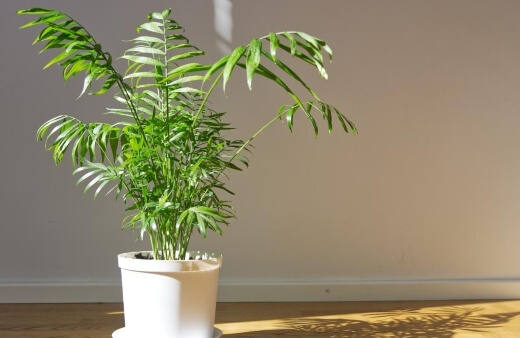
Parlour palms are rainforest floor plants, native to Southern Mexico and Guatemala. A common misconception with rainforest plans is that they need massive amounts of water, but in reality, by the time rain reaches the floor, most of it has been taken by taller trees with stronger roots, and the epiphytic plants that straddle their branches.
They do, however, need incredibly rich well drained soil and regular fertiliser, so we'll talk in more detail about that in particular later in the article. Parlour palm’s Latin name is Chamaedorea elegans, but it’s also known as a Neanthe Bella Palm.
While its common name is derived from its popularity in wealthy Victorian homes, its Latin and scientific names hint at its elegant beauty, sweeping upwards in delicate waves of lush dark green foliage.
A mature Parlour palm can reach a full height of 2m tall and spread up to 1m across, but they take over ten years to reach this sort of size, and hate to be repotted as they have weak root systems, but should only ever be repotted when the roots start to shoot out of the bottom of a pot and the top growth runs out of space for its new stems.
Once your parlour palm reaches 4-5ft tall, pay careful attention to its location, as you can actually encourage it to flower with temperatures around 21°C and misting your plant regularly.
The delicate yellow flowers shoot out from within the leaves, and can even host small berries that ripen into seed.
How to Grow Parlour Palm

Growing Indoors
Parlour palms need temperatures of 18-24°C and much higher humidity levels than most houseplants, particularly noting their natural habitat, which offers plentiful moisture in the air, with limited ground water.
This plant is happiest in part shade, mimicking their shaded position underneath towering trees in the Guatemalan rainforests. The easiest way to achieve this is by placing them on a plant stand near a window in a south-facing room away from any risk of direct light (which will quickly crisp their leaves).
We’ll cover soil conditions in more detail later, but ensure they have good compost and are watered thoroughly as soon as the top 5cm of soil has dried out.
Make sure they never sit in old water though as even in the toughest rainstorms in Guatemala, the soil drains incredibly quickly away from plants, and the heat evaporates excess surface water creating generous humidity levels.
The most important thing to remember with indoor parlour palms, different from other plants, is that they should be misted at least once a week, or kept within easy reach of a humidifier.
How to Grow Outdoors
Parlour palm grows happily outdoors in Australia but is not frost tolerant at all, so should either be moved into the greenhouse or brought indoors for winter.


Get Your Free Guide:
Master Growing Australian Natives eBook
A Must Have Complete Guide for Every Australian Garden
Get Your Free Guide:
Master Growing Australian Natives eBook
A Must Have Complete Guide for Every Australian Garden
Parlour palm is a popular house plant because they work well grown indoors (horticulturally, and visually) and since there is such a wide range of faster-growing palms we can grow outdoors in Australia, there’s really not much point trying to grow parlour palm outdoors.
If you decide to grow them outdoors though, keep them in shade, and make sure to water them generously if their soil is ever at all dry, and mist their leaves with a hose if it hasn’t rained.
Note: Australia has an average rainfall of 0.5m per year; Guatemala has an average rainfall of up to 4m per year.
Parlour Palm Propagation
This plant is a slow grower so for budget-conscious instant impact it can be more effective to propagate your own plants, either by division or by seed to maximise your stock of parlour palm.
Plus, as your plants grow taller and outgrow your home, they’ll make excellent gifts for friends and family.
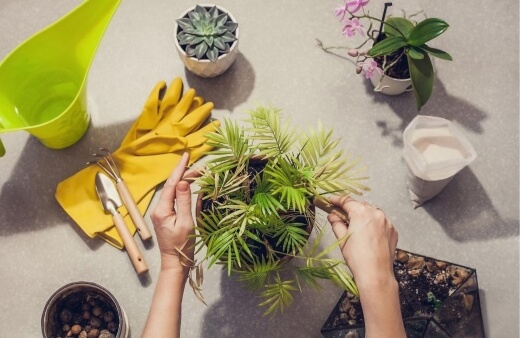
Propagating from Seed
Parlour palm is quite complicated to propagate from seed and needs high temperatures above 27°C, so a heated propagator is helpful for regulated temperatures.
Sow seeds in rich seed compost, rather than the usual houseplant potting mix you can buy in bunnings. To make a seed compost for parlour palm, sieve a good peat-free multipurpose compost, and mix with vermiculite or horticultural sand.
The resulting mix will be well drained soil but nutrient-rich and give this hungry seed a great start. Parlour palm seeds take around 4 weeks to germinate and, usually, only one-in-four seeds will germinate at all, so it’s perhaps easiest to propagate from division.
How to Propagate by Division
The most reliable way to propagate this plant is by division, and given how cheap it is to pick up young plants at nurseries, it’s almost as cost-effective as germination.
No matter how young your parlour palm is, the process of division is the same as it is for fully mature parlour palm plants.
Tip your parlour palm out of its pot and gently tease the roots apart. Be careful as they have weak root systems. You can tease out a single stem for repotting or tease out clusters (clusters of stems are advised as they help to support each other).
As the plants grow taller, their stems grow fatter, and they will begin filling the pot and fighting for space. Eventually, each stem can form a small tree in its own right, but for the first 6-7 years, you’ll get the best impact by growing parlour palm in clumps.
Chamaedorea elegans Care Tips
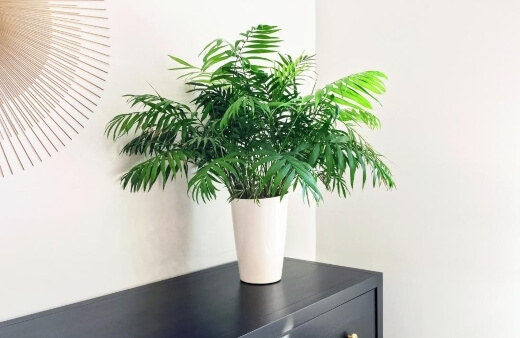
The basics of parlour palm care are; high humidity (need more humidity? Use a plant humidifier), regular water, and regular warmth. Remember that our climate here is warmer and drier, so there is a fair bit of environmental tweaking needed to grow them indoors or outdoors in Australia.
However, as long as you follow the parlour palm growing guide below, you’ll have happy healthy plants for years and years:
Mulching Tips
Parlour palm is one of the few houseplants that actually quite like mulching. If you grow them outdoors, you can mulch in spring to support growth through summer months, and ensure they are wrapped up in fleece over-winter to protect them from any risk of frost (parlour palms don't like any temperatures below 18°C).
When you mulch parlour palm you can use anything, as they will feed on any nutrients you give them without any real preferences.
(Learn the best types of mulches as well as when and how to use here.)
We use sterile multi purpose compost so as not to risk introducing any common pests or diseases, but if you have access to dried well-rotted manure, that would work too.
Just keep an eye on the base of stems for any signs of black discolouration which can be caused by overfeeding and humidity building up too quickly around the base.
How to Fertilise Chamaedorea elegans
Parlour palms are really hungry plants and, while they are sold as low maintenance houseplants, they actually like quite a lot of feeding.
Any multi purpose houseplant food will work but we use Miracle-Gro houseplant food diluted in water every four weeks, but you can extend this to every 8 weeks if you alternate between foliar feeds and liquid feeds.
(Dig into which fertiliser you can use for your plants here.)
Watering Schedule
This plant should be watered whenever the top two inches of soil are dry to touch. Test this by dipping your finger into the soil down to the second knuckle. If it comes out clean, your houseplants need water.
This is true for most house plants, but especially parlour palm. Overwatering will lead to distinctly dead or yellowing leaves, but unlike many houseplants, they do recover if you stop watering and just mist your plant regularly instead for the next 4 weeks.
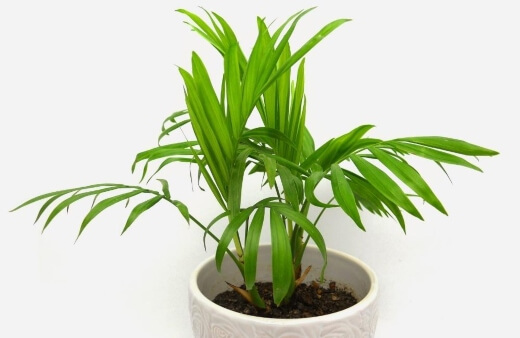
Pruning Needs
Any dead, damaged, or diseased growth should be pruned out, or even dug out of the soil with mini houseplant tools, but other than that there is no need to prune parlour palm.
When to Repot Parlour Palm
When parlour palms are outgrowing their potting media and roots appear through holes at the base, they need repotting. Pot your plant up quite generously as they are slow-growing and hate their roots being disturbed.
Once you’ve repotted, you shouldn’t need to disturb your parlour palm roots for at least the next four years.
Common Pests and Diseases

There is very little that can go fatally wrong with a parlour palm. They suffer readily from mealy bugs and spider mites, but because they are incredibly resilient plants, you can simply wipe the pests off with a clean paper towel, spray a basic organic pesticide like neem oil and then wash the leaves down with water to get rid of them.
Following pest treatment, keep an eye on the soil for a few weeks and remove any white specks that appear (these are usually mealy bugs trying to climb back onto the plant).
Parlour palm diseases are uncommon, and nearly all associated with root rot or over-watering. If you notice dead or yellowing leaves on your parlour palm, it’s almost always over-watering that causes it.
Even brown leaves can be caused by over-watering as the roots become so riddled with fungus that they fail to take water up the stems.
If there is any sign of fungus, like botrytis or grey mould, wash your palms under the shower (tip the pot so you’re spraying the fungus away from the soil) and treat it with an organic fungicide to prevent recurrences.
Once you’ve treated the problem, simply reduce watering your plant until the soil has dried out a little. In really bad circumstances, root rot will continue to affect the plant after treatment.
If the problem persists for over two weeks, tip your parlour palm out of the pot, and trim any black roots or blacking roots as this is always a sign of irretrievable root rot, and can be fatal if not removed.
This might mean removing large sections of the plant but it’s important to prevent spread.
Parlour Palm Frequently Asked Questions

Is parlour palm toxic to pets?
Parlour palm isn’t toxic to pets but if eaten in large quantities it can cause an upset stomach, and due to its long fibrous leaves can pose a choking hazard to some pets, but is a safe houseplant choice for pet owners.
Why is my parlour palm turning yellow?
Yellow parlour palm leaves are caused by overwatering. They are an early sign of fungal leaf spots and root rot as roots begin failing to feed the plant above when bacterial or fungal infection stops their ability to process nutrients.
If you catch it early, temporarily move your parlour palm to a warmer, sunnier, room, and reduce watering until the leaves begin to perk up.
Why is water running through my parlour palm pot?
Water running through a houseplant container is usually due to prolonged drought. When you forget to water plants, or summer temperatures mean you can’t keep up with watering, the soil will completely dry out.
When this happens the cell structure of the soil has shrunk back and fails to soak in new water. Simply stand the pot in a tray of water until the soil surface feels moist again.
How can I make my parlour palm grow faster?
Parlour palms grow towards the light but they are slow grower by nature. One way to trick a parlour palm into faster growth is to place it underneath a tall window, away from direct light. The leaves will grow upwards in search of light.
Looking for more plant options? Check out our guides to grow these tropical feel plants in your home:
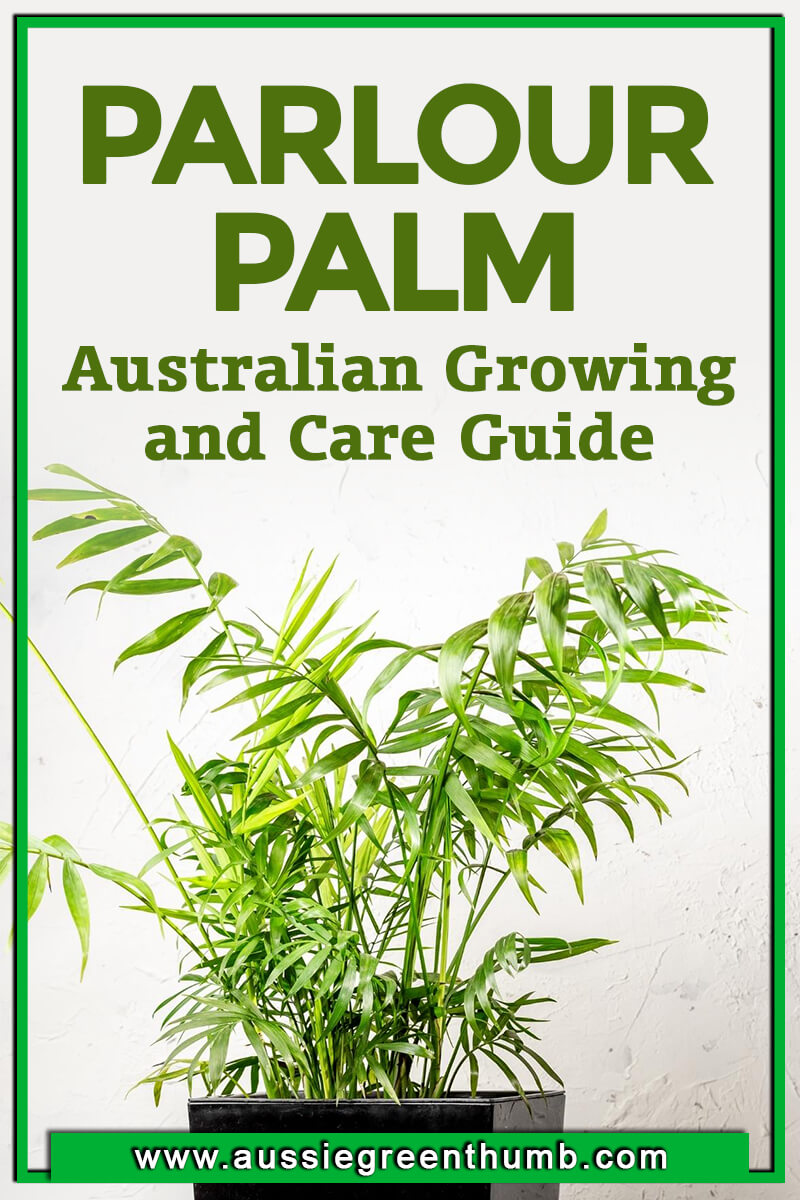
Add Some Rainforest Touch by Growing Parlour Palms
Thanks for reading our ultimate guide to growing parlour palm. We’re seven years into our growing journey, starting from a young parlour palm we bought back in 2015.
She’s nearly 4ft tall now and takes pride of place next to the conservatory doors, and it's all thanks to the tips and advice above.
We’re a long way from Victorian tea parlours and formal dress codes, but parlour palms have a timeless elegance that will always capture the imagination of their growers.
If you’re ever worried about signs of drought or over-watering, I hope you find your way back here for helpful advice and parlour palm growing tips.
Published on December 18, 2023 by Maisie Blevins
Last Updated on September 20, 2024




